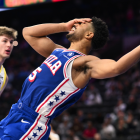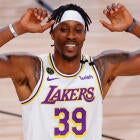When Kevin Durant strained his calf in the Golden State Warriors' second-round playoff matchup with the Houston Rockets, no firm timeline for his return was established. He was ruled out of games seemingly one at a time, and ultimately missed the entire Western Conference finals and the first four games of the NBA Finals. Little was known about his condition when he returned for Game 5 against the Toronto Raptors, but after he ruptured his Achilles tendon in less than 12 minutes of game action, fans and analysts alike came to conclusions very quickly.
The Golden State Warriors must have rushed him back, many claimed. What else could have explained such an injury? When Klay Thompson tore his ACL in Game 6, the pitchforks and torches came out in full force. Golden State's medical staff faced rampant criticism, but Durant did everything in his power during a recent interview with Chris Haynes of Yahoo Sports to dispel that notion. He refused to give the Warriors even an ounce of blame for his injury:
"Hell, no. How can you blame [the Warriors]? Hell, no," Durant told Yahoo Sports. "I heard the Warriors pressured me into getting back. Nobody never said a word to me during rehab as I was coming back. It was only me and [director of sports medicine and performance] Rick [Celebrini] working out every day. Right when the series started, I targeted Game 5. Hell, nah. It just happened. It's basketball. S--- happens. Nobody was responsible for it. It was just the game. We just need to move on from that s--- because I'm going to be back playing."
Players coming off of calf injuries face some degree of risk when it comes to their Achilles tendons, but risk is present every time a player steps on a basketball court. Injuries are a part of the game. Sometimes they are explainable by organizational malpractice, but for the most part, they are simply an unfortunate consequence of athletic competition at the highest level. All teams can do is follow best practices in the recovery process and hope their players avoid further injury. That appears to be what the Warriors did, as Durant detailed his rehabilitation to Haynes.
"No matter what the series was, I was aiming for Game 5," he said. "That's why I played when it was 3-1. No matter what, I just wanted to play in the Finals. I just wanted to hoop, especially if I could be out there. I was feeling good leading up to it. I was working out every day. I was gradually getting back to myself doing the two-a-days. I was really locked in on my game and trying to get back. I really wanted to play in that series."
Golden State's training staff has a strong track record. It helped Stephen Curry overcome the ankle injuries that plagued the early portion of his career, and during their five-year run of consecutive NBA Finals appearances, they have had only one full-time starter miss more than 20 games in a season due to injury (Curry in 2017 with an MCL sprain). No team is perfect when it comes to managing injuries, but the Warriors are among the best in basketball.
And it should be enough to dispel the notion that Golden State rushed Durant back onto the floor. Playing him was always going to be risky, but if all calf injuries equated to time bombs, we'd see dozens of ruptured Achilles tendons every year. By Durant's own admission, the Warriors handled the injury properly. But even doing everything right can't always prevent the wrong thing from happening.
![[object Object] Logo](https://sportshub.cbsistatic.com/i/2020/04/22/e9ceb731-8b3f-4c60-98fe-090ab66a2997/screen-shot-2020-04-22-at-11-04-56-am.png)



















